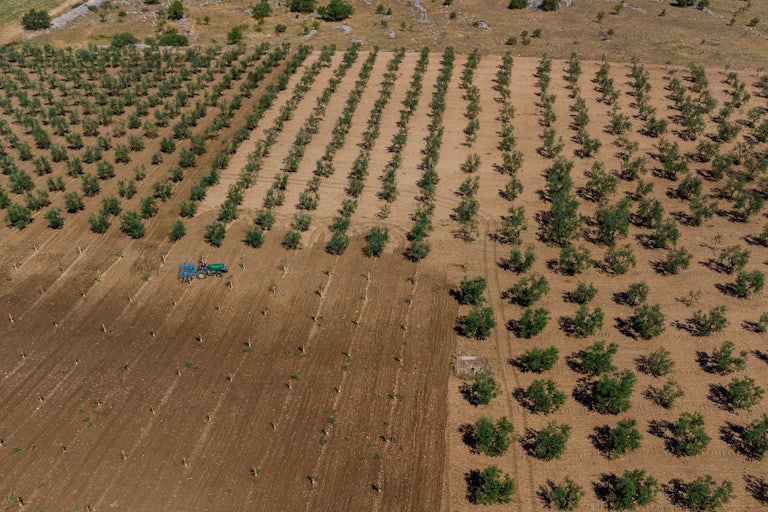Companies Legally Use Poison to Make Your Decaf Coffee
And they are fighting every effort to ban it.

Do you drink decaffeinated coffee? Are you aware that it’s often made by applying a chemical so dangerous it was banned for use in paint stripper five years ago? And are you aware that companies think banning this chemical is really, really unfair?
This week the Environmental Protection Agency finalized a rule prohibiting all but “critical” uses of methylene chloride, a highly toxic liquid that is believed to have killed at least 88 people since 1980—mostly workers refinishing bathtubs or doing other home renovations. Methylene chloride can cause liver damage and is linked to multiple cancers, among other health effects. Amazingly, while the EPA banned its sale for paint stripping in 2019 for this reason, it continues to be used for a lot of other purposes. And one of those is decaffeinating coffee, because the Food and Drug Administration decided in the 1980s that the risk to coffee drinkers was low given how the coffee was processed.
The EPA’s ban on noncritical use of methylene chloride is one of many rules the Biden administration has announced or finalized ahead of the Congressional Review Act deadline. (The CRA, essentially, makes it easier for an unfriendly Congress to nix any administrative regulations finalized in the last 60 days of a legislative session.) A lot of the recently announced rules ban or curtail toxic substances that have made their way into everyday life and are poisoning people. The EPA has limited long-lasting chemicals called PFAS in drinking water, requiring water utilities within five years to build treatment systems that remove it. The agency has categorized two types of PFAS as hazardous substances under the Superfund law, requiring manufacturers to monitor whether they’ve been released into the environment and, if so, clean them up. It has also—finally—fully banned asbestos. It’s finalized a rule to further restrict fine particulate pollution in the air, which has been linked to heart disease, heart attacks, asthma, low birth weight, Alzheimer’s, and other forms of dementia. It’s in the process of finalizing a rule reducing lead in drinking water, which would require the replacement of lead pipes throughout the nation.
Banning poison is good politics. As mentioned in last week’s newsletter, while only 47 percent of respondents in a recent CBS News poll supported reentering the Paris climate agreement, 70 percent said they supported reducing toxic chemicals in drinking water. That’s consistent with other polls showing that a majority of people think the federal government is doing too little to protect “lakes, rivers and streams,” and that an overwhelming majority of people—even 68 percent of Republicans—believe the federal government should play some role in “addressing differences across communities in their health risks from pollution and other environmental problems.”
But every single time one of these rules is announced, companies and industry groups respond with the most ridiculous statements. Let’s look at just a few recent examples.
“A group of coffee makers against banning methylene chloride,” Boston radio station WBUR reported in early April, “recently wrote the FDA saying, ‘True coffee aficionados in blind tastings’ prefer coffee decaffeinated with the chemical.” Who knows how this study was done—“True coffee aficionados” are not known for preferring decaf, period, hence a recent P.R. push to improve decaf’s image. Nick Florko, a reporter for health news website Stat, told WBUR that the coffee makers’ letter to the FDA was a “pretty funny claim if you consider the fact that we’re talking about coffee here that’s essentially rinsed in paint thinner.” And this says nothing at all about what happens to workers involved in the decaffeination process. (Methylene chloride has previously been shown to poison even trained workers wearing protective gear.)
National Coffee Association president William Murray said something even weirder, telling CNN via email that banning methylene chloride “would defy science and harm American[s’] health.” His logic appeared to be that since all coffee consumption, including decaf, shows signs of reducing cancer risk overall, it’s not really a problem to decaffeinate coffee using a known carcinogen. That’s loopy even for industry pushback. For one thing, it’s easy to imagine that coffee could be good in general, and less good if you add poison to it. For another, coffee can also be decaffeinated without methylene chloride, using only water.
Now let’s look at PFAS pushback. Knowing the EPA rules were in progress, the U.S. Chamber of Commerce in March launched the “Essential Chemistry for America” initiative, with the goal of “protecting ‘forever chemicals’ it deems ‘critical,’” according to E&E News. “We’re increasingly concerned that overly broad regulatory approaches threaten access to modern fluorochemistries, so we’re taking action to ensure their availability,” chamber vice president Marty Durbin said. Given that “access” language is typically used in a social and environmental justice context, restyling the regulation of poisons as threatening “access to modern fluorochemistries” is gutsy, to say the least.
The private water industry is meanwhile throwing a fit about being asked to filter out PFAS. The rule will “throw public confidence in drinking water into chaos,” Mike McGill, president of water industry communications firm WaterPIO, told the AP. (You’d think the existence of PFAS in the water is what would tank public confidence, not the requirement that it be removed.) Then there’s the common threat from private water utilities—which, remember, turn a profit off providing a substance people can’t live without—that removing PFAS will increase people’s water bills. Robert Powelson, the head of the National Association of Water Companies, said that the costs of the federal regulation “will disproportionately fall on water and wastewater customers,” according to The Washington Post. “Water utilities do not create or produce PFAS chemicals,” Powelson added. “Yet water systems and their customers are on the front lines of paying for the cleanup of this contamination.”
It’s true enough that water utilities are not the ones creating PFAS chemicals. On the other hand, there are lots of water contaminants that water utilities are responsible for filtering out if they want to keep making money from providing people with drinking water. Is there really any reason PFAS shouldn’t be among them?
Saying that the cost of this regulation “will disproportionately fall on water and wastewater customers” shouldn’t be read as an expression of sympathy for disadvantaged households. The burden will fall on customers because the utilities will make sure of it. It’s a threat, and one that doesn’t mention the federal money from the Inflation Reduction Act that is being made available to help shoulder that burden. Those funds may well fall short, but that doesn’t change the fact that they’re paying for-profit entities to transition to removing something they ought to have been filtering out long ago. And even if this federal rule hadn’t been made, companies would probably have to start removing PFAS anyway, because they are facing increasingly expensive lawsuits over not doing so. (The water utilities, in turn, are suing polluters to cover remediation costs—another source of funding.)
It’s worth emphasizing what PFAS chemicals actually do to people, particularly in light of the American Water Works Association’s assertion to the AP that the cost of removing the chemicals “can’t be justified for communities with low levels of PFAS.” Researchers are now pretty sure that PFAS exposure increases the risk of dying from cardiovascular disease. Studying people in northern Italy who drank PFAS-contaminated water, researchers also saw increased rates of kidney and testicular cancer. The Guardian report on this contained this disturbing finding too: Women with multiple children had lower levels of PFAS only because pregnancy transferred PFAS into their children’s bodies instead.
Don’t let that get in the way of a good comms statement from industry groups, though. Remember: Forcing companies even to report their PFAS pollution, or remove PFAS from the water, is unfair.
Good News/Bad News
![]()
Twenty-nine-year-old Andrea Vidaurre has won the Goldman Environmental Prize for her work in environmental justice, pushing California to adopt new standards for truck and rail emissions that will curtail the air pollution harming working-class Latino communities in California’s Inland Empire.
![]()
The United States has sided with petrostates in opposing production controls on plastic at the negotiations in Ottawa for a U.N. treaty to reduce plastic pollution. (Two weeks ago, I wrote about these negotiations, noting that the number of plastics industry lobbyists attending this session was not yet known. Now it is: 196 lobbyists from the fossil fuel and chemical industries registered for this round, according to the Center for International Environmental Law—a 37 percent increase from the number at the last session.)
Stat of the Week
9.6%
That’s the percentage of the 250 most popular fictional films released between 2013 and 2022 in which climate change exists and a character depicted on screen knows it, according to a new “Climate Reality Check” analysis from Colby University and Good Energy. Read Sammy Roth’s newsletter about why climate change in movies is so important here.
What I’m Reading
Congressional Democrats this week released a report confirming what news outlets have previously reported: Companies like Exxon knew about climate change very early on and covered it up. They also found in subpoenaed emails that Exxon tried to discredit reporting of its duplicity, while privately acknowledging that it was true:
The new revelations build on 2015 reporting from Inside Climate News and the Los Angeles Times, which found that Exxon was for decades aware of the dangers of the climate crisis, yet hid that from the public.
At the time, Exxon publicly rejected the journalists’ findings outright, calling them “inaccurate and deliberately misleading.” … But in internal communications, Exxon confirmed the validity of the reporting. In a December 2015 email about a potential public response to the investigative reporting, Exxon communications advisor Pamela Kevelson admitted the company did not “dispute much of what these stories report.” … “It’s true that Inside Climate News originally accused us of working against science but ultimately modified their accusation to working against policies meant to stop climate change,” Alan Jeffers, then a spokesperson for Exxon, wrote in a 2016 email to Kevelson. “I’m OK either way, since they were both true at one time or another.”
Read Dharna Noor’s report in The Guardian.
This article first appeared in Life in a Warming World, a weekly TNR newsletter authored by deputy editor Heather Souvaine Horn. Sign up here.








